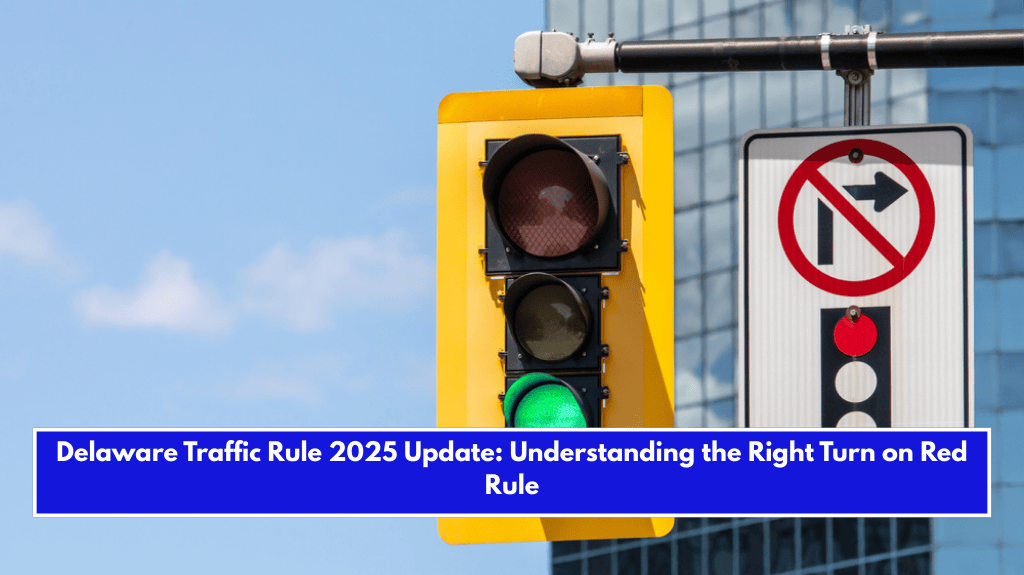Overview of Right Turn on Red (RTOR)
The principle of Right Turn on Red (RTOR) allows vehicles to turn right at a red traffic signal after coming to a complete stop, provided there is no signage prohibiting such a turn and the way is clear of pedestrians and other vehicles. This rule is widely implemented across the United States, including Delaware, to improve traffic flow and reduce delays at intersections.
Delaware’s Specific RTOR Regulations
Delaware law permits RTOR under specific conditions outlined in Title 21, Chapter 41 of the Delaware Code. Drivers facing a circular red signal may cautiously enter the intersection to turn right after stopping fully unless a traffic control device prohibits such turns. However, RTOR is strictly prohibited when a steady red arrow signal is displayed.
Key Conditions for RTOR:
- Full Stop Requirement: Drivers must come to a complete stop before proceeding with the turn.
- Yielding: Vehicles must yield to pedestrians in crosswalks and other traffic that has the right-of-way.
- Prohibited Turns: RTOR is not allowed if there is a “No Turn on Red” sign or if the signal displays a steady red arrow.
- Pedestrian Safety: Pedestrians have priority, and drivers must ensure their maneuver does not interfere with pedestrian movement.
Updates in 2025
Recent updates emphasize stricter enforcement and additional safety measures for RTOR in Delaware. These changes aim to address pedestrian safety concerns and reduce conflicts at intersections.
Key Changes:
- Enhanced Signage: The use of “No Turn on Red” signs has been expanded based on engineering studies that identify intersections with high pedestrian activity or limited visibility.
- Signal Modifications: New traffic signals include flashing yellow arrows for permissive right-turn movements, which require drivers to yield before turning. This update provides clearer guidance to drivers.
- Safety Studies: Delaware has conducted studies showing increased pedestrian and bicyclist risks associated with RTOR maneuvers. As a result, some intersections now prohibit RTOR entirely during exclusive pedestrian phases or high-risk conditions.
Safety Concerns Associated with RTOR
While RTOR improves traffic efficiency, it poses risks to pedestrians and bicyclists. Studies indicate that allowing RTOR increases pedestrian crashes by approximately 60% and bicyclist crashes by 100% at signalized intersections. These findings have led Delaware to implement stricter controls at high-risk locations.
Mitigation Measures:
- Exclusive Pedestrian Phases: Intersections with heavy foot traffic may feature pedestrian-only signal phases during which RTOR is prohibited.
- Improved Visibility: Engineering adjustments ensure drivers have adequate sight distance before attempting RTOR.
- Public Awareness Campaigns: Efforts are underway to educate drivers about safe practices for RTOR and the importance of yielding to pedestrians.
Enforcement Mechanisms
Delaware employs electronic monitoring systems, such as red-light cameras, at select intersections to enforce compliance with traffic rules, including RTOR regulations. Violations are reviewed manually to ensure accuracy before citations are issued.
Penalties:
Drivers who fail to comply with RTOR rules may face fines ranging from $75 to $230 for first offenses, with increased penalties for repeat violations within two years.
The 2025 updates to Delaware’s RTOR regulations reflect the state’s commitment to balancing traffic efficiency with roadway safety. By enhancing signage, modifying traffic signals, and enforcing stricter penalties, Delaware aims to mitigate risks associated with RTOR while ensuring smooth traffic flow. Drivers are encouraged to familiarize themselves with these changes and prioritize pedestrian safety at intersections.
Sources:
- https://www.law.cornell.edu/regulations/delaware/2-Del-Admin-Code-SS-4D.22
- https://law.justia.com/codes/delaware/title-21/chapter-41/subchapter-ii/section-4108/
- https://news.delaware.gov/2023/06/30/governor-carney-signs-package-of-roadway-safety-legislation/
- https://regulations.justia.com/states/delaware/title-2/2000/2400/2402/part-4/chapter-4d/section-4d-04/
- https://rosap.ntl.bts.gov/view/dot/1555/dot_1555_DS1.pdf














